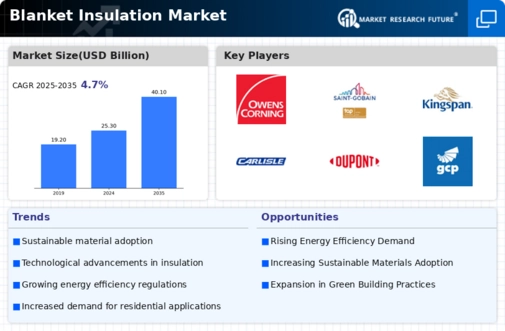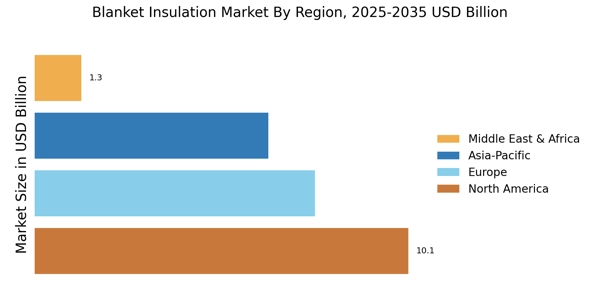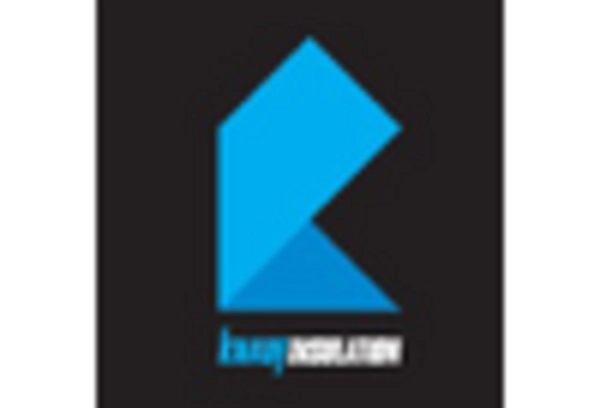Growing Construction Activities
The resurgence of construction activities across various sectors is significantly influencing the Blanket Insulation Market. With urbanization and population growth, there is a heightened demand for residential, commercial, and industrial buildings. This surge in construction is accompanied by a parallel need for effective insulation solutions to ensure energy efficiency and comfort. According to recent data, the construction sector is expected to expand at a rate of approximately 4% annually, thereby bolstering the demand for blanket insulation products. Builders are increasingly recognizing the value of high-performance insulation materials, which not only enhance energy efficiency but also contribute to overall building performance. Consequently, the Blanket Insulation Market is poised for growth as it aligns with the evolving needs of the construction landscape.
Rising Energy Efficiency Standards
The increasing emphasis on energy efficiency standards is a pivotal driver for the Blanket Insulation Market. Governments and regulatory bodies are implementing stringent regulations aimed at reducing energy consumption in buildings. This trend is evident in various regions, where energy codes mandate higher insulation levels in residential and commercial structures. As a result, builders and homeowners are increasingly opting for blanket insulation solutions to comply with these standards. The market for blanket insulation is projected to grow as more entities seek to enhance energy efficiency, with estimates suggesting a compound annual growth rate of around 5% over the next few years. This regulatory push not only promotes sustainability but also drives innovation within the Blanket Insulation Market.
Demand for Energy-Efficient Retrofits
The growing trend of energy-efficient retrofitting is a crucial driver for the Blanket Insulation Market. As existing buildings seek to improve their energy performance, the demand for effective insulation solutions is on the rise. Retrofitting projects often prioritize insulation upgrades to enhance energy efficiency and reduce operational costs. Data suggests that the retrofitting market is expanding, with a significant portion of investments directed towards insulation improvements. This trend is particularly evident in older buildings that require modernization to meet current energy standards. Consequently, the Blanket Insulation Market stands to benefit from this shift, as more property owners and managers recognize the value of investing in high-quality insulation solutions to achieve energy savings.
Increased Awareness of Environmental Impact
The heightened awareness regarding environmental sustainability is driving the Blanket Insulation Market. Consumers and businesses alike are becoming more conscious of their ecological footprint, leading to a preference for eco-friendly insulation materials. Blanket insulation, particularly those made from recycled or sustainable materials, is gaining traction as a viable option for reducing energy consumption and greenhouse gas emissions. Market data indicates that products with sustainable certifications are witnessing increased demand, as consumers prioritize environmentally responsible choices. This shift in consumer behavior is likely to propel the Blanket Insulation Market forward, as manufacturers adapt their offerings to meet the growing demand for sustainable insulation solutions.
Technological Innovations in Insulation Materials
Technological advancements in insulation materials are reshaping the Blanket Insulation Market. Innovations such as improved thermal performance, enhanced fire resistance, and moisture control are making blanket insulation products more effective and appealing to consumers. Manufacturers are investing in research and development to create advanced materials that not only meet regulatory standards but also exceed consumer expectations. For instance, the introduction of reflective insulation and multi-layered systems is enhancing the overall performance of blanket insulation. As these technologies become more prevalent, they are likely to drive market growth, with projections indicating a potential increase in market share for technologically advanced insulation solutions within the Blanket Insulation Market.


















Leave a Comment